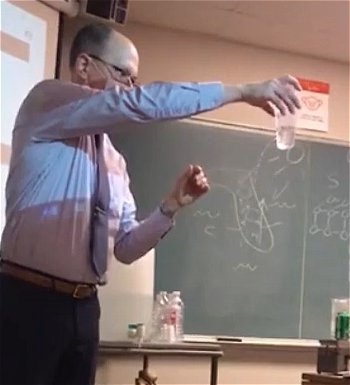
I started teaching it just because I enjoy working with Dr. Carr, but I have continued teaching it because the class is really fun. A good portion of the class time is spent having students come up with experiments that their students could either do or watch. Of course, I have seen all sorts of science experiments for elementary students, and my elementary series actually contains a total of 450 of them. Nevertheless, every year I see at least one new experiment or a new variation on an experiment I already know. This year is no exception. We have only been in class for two weeks, and already, a student named Melodie Nord presented a great experiment that shows gravity accelerates all objects at the same rate. A slow-motion video of it is given below:
As you can see in the video, water is falling out of a hole near the bottom of the cup in a stream. However, once the cup is released, the water stops falling out of the hole. It is still falling, of course, but the cup is falling with it. Since the cup and its entire contents fall at the same rate as the water that would have come out of the hole, the cup “keeps up” with the stream that was coming out of the hole. As a result, there is no stream of water. This shows that whether it is a tiny drop of water or a cup full of water, gravity accelerates everything at the same rate, regardless of mass.
I have a plaque on my wall that says “Docendo Discimus,” which is a Latin proverb that means, “By teaching, we learn.” It is true whether I am teaching nuclear physics at the graduate level or STEM for elementary education majors!



